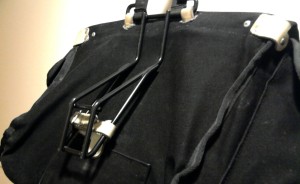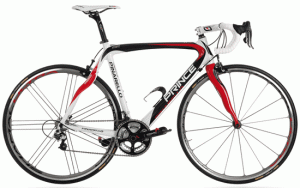Product: Carradice SQR System| RRP: £26.95

The humble, venerable saddlebag is, and has always been, a great way to carry moderate loads on a bike. The bag sits neatly in the slipstream of the rider, high enough to avoid being snagged on gateposts and undergrowth (if you’re riding off road) and out of the spray and grime (when you’re on the tarmac). Traditionally, saddlebags are attached to the bike by straps which thread through saddle loops on Brooks saddles with another strap which wraps around the seatpost, meaning that you don’t need a rack, keeping your bike a little leaner when you’re not toting a load.
The problem
One downside with traditional saddlebags is the faffing around involved in attaching a reattaching them. Another is that many modern saddles don’t have the necessary saddle loops to attach a saddlebag. Step up the SQR system from Carradice, which makes removing and attaching the saddlebag a two second affair and also allows a traditional saddlebag to be carried on a bike without saddlebag loops.
The solution?

The Carradice SQR comprises two main parts; a strong, rigid, powder-coated steel bracket to which the saddlebag is attached using it’s standard leather straps; and a tough ABS plastic bracket that attaches securely to the seatpost with two stainless steel bands. The bracket contains a spring loaded retainer which means that, once attached, the bag and bracket cannot break free.

Two sizes of stainless steel bracket are available; the standard bracket s fit seatposts from 25mm to 32mm, while the oversized version fits post sizes 32mm plus, therefore ideal for folding bikes with large diameter seatposts.
The attaching and detaching procedure is simple. To attach, you just offer up the bottom rung of the bracket to the slot at the bottom of the seatpost bracket, pull back the red spring-loaded retainer, drop the bag into position and release the spring. Detaching, as they say in instruction manuals the world over, is the reverse of attaching. Bottom line is that it’s quick and intuitive.
Once detached, another neat feature becomes apparent when you’re carrying your bag into work/college/shops. The black metal frame incorporates a black webbing carry-handle, making bike to workplace portage a cinch.
If you’ve got more than one bike, you can buy additional seatpost brackets, meaning you can hot swap your saddlebag from bike to bike. The SQR metal frame fits all the bags in the Carradice range, from Barley (tiddly and small!) to Camper (freaking huge!) and other traditional saddlebags that are designed to fit laterally across the bike attached to the saddlebag loops.
Other solutions
The SQR isn’t the only quick release option for traditional saddlebags. Carradice also market the Bagman, which is a more traditional saddlebag support with a quick release. This also allows non-loop equipped saddles to mesh with saddlebags. However (though I’ve never used one) the attach-detach system doesn’t look quite as slick as the SQR and the rack remains in position when the bag’s not on the bike. It does however, give the bag some support at the bottom, which some riders with low saddles, might appreciate. For me, however, with my high saddle, it’s not an issue.
The boat-cleat trick
A quirky DIY approach using a boat cleat bought from a marine hardware shop (that I’m too chicken to try), but it might work for you! Check out the YouTube link.
Summary: A simple, tough, cleverly though out solution to a generations-old saddlebag toting problem.
Rating: theeverydaycyclist double thumbs up (that’s pretty darn good)
Link: www.carradice.co.uk
NB: This is a non-sponsored, honest to goodness, ‘I use this every day’ review – not some rehashed product press release.



